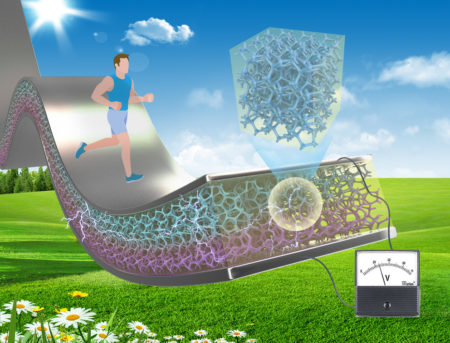May
24
Penn State researchers believe they have developed a 10-fold increase in the ability to harvest mechanical and thermal energy over standard piezoelectric composites. The new system may be possible using a piezoelectric ceramic foam supported by a flexible polymer support.

A 10-fold increase in the ability to harvest mechanical and thermal energy over standard piezoelectric composites may be possible using a piezoelectric ceramic foam supported by a flexible polymer support, according to Penn State researchers. Image Credit: The Wang Lab at Penn State. Click image for the largest view.
In the search for ways to harvest small amounts of energy to run mobile electronic devices or sensors for health monitoring, researchers typically add hard ceramic nanoparticles or nanowires to a soft, flexible polymer support. The polymer provides the flexibility, while the piezo nanoparticles convert the mechanical energy into electrical voltage. But these materials are relatively inefficient, because upon mechanical loading the mechanical energy is largely absorbed by the bulk of the polymer, with a very small fraction transferred to the piezo nanoparticles. While adding more ceramic would increase the energy efficiency, it comes with the tradeoff of less flexibility.
Qing Wang, Penn State professor of materials science and engineering said, “The hard ceramics in the soft polymer is like stones in water. You can slap the surface of the water, but little force is transferred to the stones. We call that strain-transfer capability.”
Almost three decades ago, the late Penn State materials scientist Bob Newnham came up with the concept that the connectivity of the piezo filler determined the efficiency of the piezoelectric effect. A three-dimensional material would be more efficient than what he classified as zero-dimensional nanoparticles, one-dimensional nanowires or two-dimensional films, because the mechanical energy would be transported directly through the three-dimensional material instead of dissipating into the polymer matrix.
Wang noted, “Bob Newnham was a legend in the field of piezoelectrics, so everybody in the ceramic community knew of his approach, but how to achieve that 3-D structure with a well-defined microstructure remained a mystery.”
The secret ingredient to solve the mystery turned out to be a cheap polyurethane foam dusting sheet that can be purchased at any home improvement store. The small uniform protrusions on the sheet act as a template for forming the microstructure of the piezoelectric ceramic. The researchers applied the ceramic to the polyurethane sheet in the form of suspended nanoparticles in solution. When the template and solution are heated to a high enough temperature, the sheet burns out and the solution crystallizes into a solid 3-D microform foam with uniform holes. They then fill the holes in the ceramic foam with polymer.
“We see that this 3-D composite has a much higher energy output under different modes,” said Wang. “We can stretch it, bend it, press it. And at the same time, it can be used as a pyroelectric energy harvester if there is a temperature gradient of at least a few degrees.”
Sulin Zhang, a professor of engineering science and mechanics at Penn State is the other corresponding author on the paper “Flexible Three-Dimensional Interconnected Piezoelectric Ceramic Foam Based Composites For Highly Efficient Concurrent Mechanical and Thermal Energy Harvesting,” published in Energy and Environmental Science. Zhang and his students were responsible for extensive computational work simulating the piezoelectric performance of the 3-D composite.
Zhang explained, “We were able to show theoretically that the piezoelectric performance of nanoparticle/nanowire composites is critically limited by the large disparity in stiffness of the polymer matrix and piezoceramics, but the 3-D composite foam is not limited by stiffness. This is the fundamental difference between these composite materials, which speaks to the innovation of this new 3-D composite. Our extensive simulations further demonstrate this idea.”
Currently, Wang and his collaborators are working with lead-free and more environmentally friendly alternatives to the current lead-zirconium-titanate ceramic.
“This is a very general method,” said Wang. “This is to demonstrate the concept, based on Bob Newnham’s work. It is good to continue the work of a Penn State legend and to advance this field.”
There is quite a list of collaborators. Additional authors are o-lead authors Guangzu Zhang, formerly in Wang’s group and now at Huazhong University of Science and Technology, China; and Peng Zhao, a doctoral student in Zhang’s group. Other contributors are Xiaoshin Zhang, Kuo Han, Tiankai Zhao, Yong Zhang, Chang Kyu Jeong and Shenglin Jiang.
A 10-fold increase all at once in this field is astonishing and very welcome indeed. If they only get an 8-fold increase is still huge. They may do even better than 10 if the material research gets great results.
If low cost enough, there are ideas stacked up for low power devices that could get to market without batteries or other power sources to put a drag on marketability.
Go Penn State!!
Comments
1 Comment so far


The researchers applied the ceramic to the polyurethane sheet in the form of suspended nanoparticles in solution. When the template and solution are heated to a high enough temperature, the sheet burns out and the solution crystallizes into a solid 3-D microform foam with uniform holes.